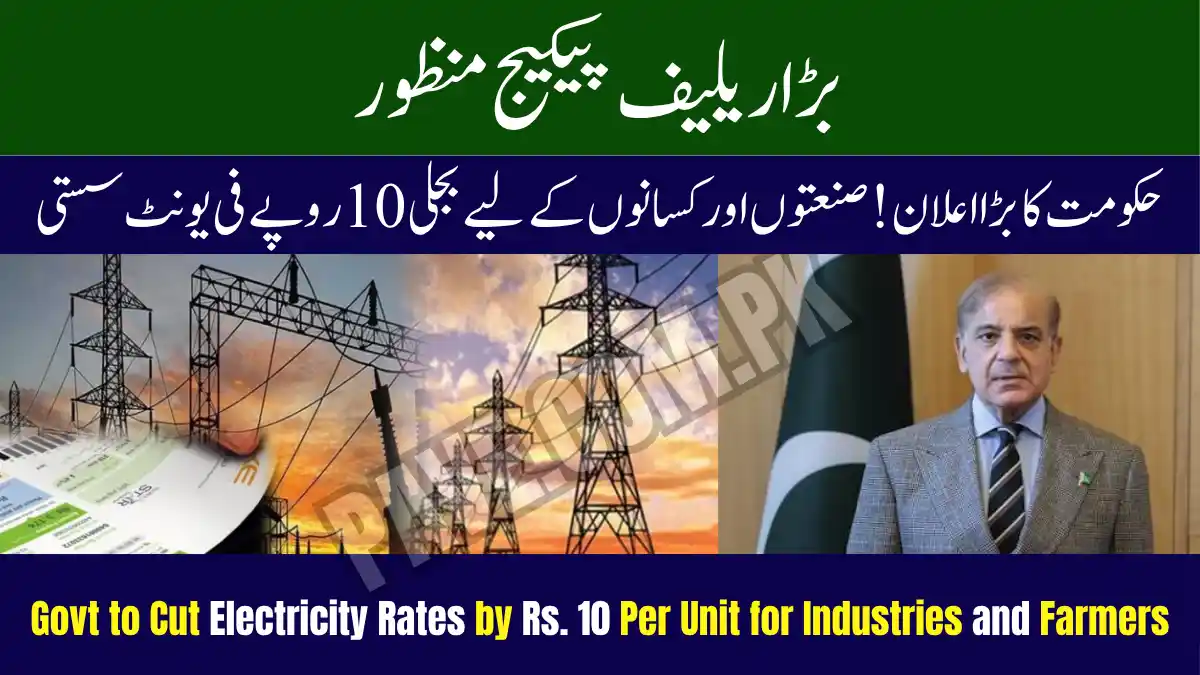Govt to Cut Electricity Rates by Rs. 10 Per Unit for Industries and Farmers — Major Relief Package Approved
In a major step toward reviving Pakistan’s struggling economy, the federal government has approved a historic electricity relief package that will cut power tariffs by Rs. 10 per unit for the industrial and agricultural sectors.
The move, set to take effect from November 1, 2025, is part of a three-year national energy reform plan aimed at lowering production costs, boosting exports, and supporting farmers hit by rising input expenses. Officials describe it as a “transformational initiative” that will strengthen the backbone of the economy — Pakistan’s industries and agriculture.
A Power Cut That Sparks Growth
According to government sources, the new tariff plan will reduce electricity rates by Rs. 10 to Rs. 12 per unit, depending on usage categories and regional consumption patterns. The scheme will remain valid until October 31, 2028, offering long-term stability for factories, farms, and agri-based enterprises.
The relief package will apply to incremental consumption, meaning industries and farmers will receive discounted rates on additional units consumed beyond their baseline usage. The goal is to encourage higher energy consumption for production, driving efficiency and expansion across sectors.
Prime Minister Shehbaz Sharif is expected to formally unveil the package on Thursday, with the announcement focusing on his administration’s broader commitment to economic revival through affordability, productivity, and sustainability.
A Three-Year Plan for Energy Stability
The government’s decision isn’t a one-off subsidy — it’s part of a carefully structured three-year relief framework designed to promote growth while maintaining fiscal discipline.
The Power Division and Finance Ministry have jointly formulated the plan to ensure that the relief is targeted, measurable, and transparent. A monitoring committee will track results quarterly, reviewing performance, energy savings, and industrial growth indicators.
Officials confirmed that the federal exchequer will bear the cost through reallocation of energy efficiency savings, avoiding additional borrowing. This, they say, makes the program financially sustainable without adding pressure to the national budget.
Key Objectives of the Rs. 10 Relief Package
The government aims to accomplish multiple goals through this landmark decision:
- Reduce cost of production for export industries and local manufacturers.
- Encourage industrial expansion and job creation through affordable power.
- Support farmers in operating tube wells and irrigation systems more efficiently.
- Enhance agricultural yields by lowering input costs for small and medium farms.
- Increase electricity consumption through legitimate channels, improving billing recovery.
- Boost exports by helping Pakistani goods compete with regional markets.
“This relief is not a subsidy—it’s an investment in Pakistan’s productivity and competitiveness,” said a senior energy ministry official. “Every unit of power saved or consumed efficiently adds value to our economy.”
Read More: Today Gold Rate in Pakistan 23 October 2025
Industries to Benefit Most
Energy-intensive sectors such as textiles, cement, fertilizer, and steel are expected to see immediate benefits. Reduced electricity rates will lower their operational costs by up to 15–20%, giving them room to increase output and exports.
For example, Pakistan’s textile industry — which accounts for over 60% of total exports — could save billions in production costs annually. The All Pakistan Textile Mills Association (APTMA) estimates that the relief could revive dormant units, enhance capacity utilization, and create thousands of jobs.
“This is exactly the kind of policy intervention we’ve been waiting for,” said a senior representative from APTMA. “Affordable power means we can run more shifts, improve exports, and regain competitiveness globally.”
Agriculture Sector: Cheaper Power, Higher Yields
The agriculture sector, often neglected in previous energy reforms, will be a major beneficiary of this package.
Farmers will enjoy discounted electricity rates for tube wells, irrigation systems, and small agri-processing units. The savings are expected to reduce farming costs, helping farmers reinvest in seeds, fertilizers, and equipment.
By lowering input costs, the government hopes to increase national crop output and stabilize food prices — a win-win situation for both producers and consumers.
Economic Experts Call It a ‘Strategic Stimulus’
Economists have praised the move as a strategic stimulus package that could inject new life into Pakistan’s real economy.
Dr. Hamid Malik, an energy economist, said the plan is not only timely but also sustainable if backed by reforms. “This is the first time the government is offering a structured, three-year power relief instead of short-term subsidies. If implemented transparently, it will trigger industrial revival and rural growth simultaneously.”
He added that the link between affordable energy and export growth is well-documented globally, citing similar policies in India and Bangladesh that boosted competitiveness in their manufacturing sectors.
How It Works: The “Productivity Power Tariff” Framework
The new plan introduces what insiders are calling the Productivity Power Tariff (PPT) system — a mechanism where industries and farmers pay lower rates on incremental energy use beyond their average historical consumption.
For instance:
- A factory that consumed 1 million units last year will pay Rs. 10 less per unit on any additional usage above that level.
- A farmer using 500 units for tube wells will get discounted power on every extra unit consumed during high-demand months.
The logic is simple: reward higher production and efficiency while ensuring energy utilization remains within sustainable limits.
Read More: Lahore & Karachi Among World’s Top 5 Most Polluted Cities 2025
Broader Energy Reforms on the Way
While the Rs. 10 per unit relief is the headline measure, the government is also preparing a comprehensive energy reform roadmap for 2026–2028, which includes:
- Expanding renewable energy generation from solar and wind to cut generation costs.
- Modernizing transmission networks to reduce line losses.
- Digitizing billing systems for transparency and recovery improvements.
- Promoting public-private partnerships in energy production.
Officials believe that by 2028, Pakistan could achieve energy self-sufficiency while maintaining affordable electricity rates for both consumers and industries.
Farmers’ Associations and Business Leaders React
The announcement has been widely welcomed across business and agricultural circles.
The Pakistan Kisan Ittehad (PKI) called the move “historic,” saying it will directly benefit small farmers and help modernize the agricultural economy. “Affordable electricity is a lifeline for farmers who rely on tube wells for irrigation. This decision will increase production and reduce food inflation,” said PKI Chairman Khalid Mahmood.
Similarly, the Lahore Chamber of Commerce and Industry (LCCI) issued a statement praising the relief, urging the government to maintain transparency and ensure that the benefits reach end-users without bureaucratic hurdles.
Prime Minister’s Upcoming Address: Energy for Progress
Prime Minister Shehbaz Sharif will officially launch the package in a televised address later this week, expected to outline his government’s economic recovery vision.
According to insiders, the PM’s speech will highlight energy affordability as the cornerstone of industrial growth. He is likely to emphasize that this package is a national productivity initiative, not a temporary subsidy.
A senior cabinet member hinted that the government will also introduce an Export Growth Fund to complement the relief package, helping industries upgrade technology and improve competitiveness.
A Boost for Confidence and Stability
The Rs. 10 per unit relief package is more than an energy policy — it’s a signal of economic stability. After months of uncertainty, it demonstrates that Pakistan is taking practical, growth-oriented steps to support production and exports rather than relying solely on borrowing or short-term aid.
By focusing on affordability and efficiency, the plan aims to restore investor confidence and improve employment opportunities, especially in manufacturing hubs such as Faisalabad, Karachi, and Multan.
Read More: Punjab Education Department Imposes New Rules for Students Failing Two or More Subjects
The Road Ahead
While challenges remain — from circular debt to infrastructure inefficiencies — this relief package sets a strong precedent for policy continuity and forward planning.
If implemented effectively, it could help Pakistan move closer to sustainable energy pricing, stronger exports, and more resilient agriculture.
In a country where power costs have often strangled growth, this Rs. 10 per unit relief marks a rare moment of optimism — a bold attempt to turn electricity from an obstacle into an engine of opportunity.
For millions of workers, business owners, and farmers, it represents hope — hope that affordable energy can power prosperity once again.







